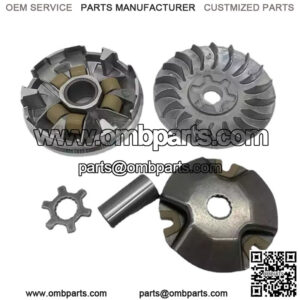In order to optimize snowmobile clutch system efficiency, it is important to have a general understanding of the system’s various components and how they work. The following report from Gates Corporation examines the three basic components of the clutch system – the primary or primary engine pulley, the secondary pulley and the belt.
Unlike an automotive transmission system, the belt and pulley mechanism on a snowmobile serves as both the clutch and the gear system. In making the transition from a starting gear ratio to the final “top gear,” the snowmobile uses two belt pulleys which have the ability to open and close axially (sideways) so that a specially designed belt can ride in various positions in each pulley.
Fig. 1 illustrates a typical clutch system. The system’s primary pulley is located on the engine crankshaft and serves as the clutch and engine rpm controlling device (via centrifugal weights). The secondary pulley has a torque-sensing capability allowing the belt drive to shift automatically to an appropriate ratio.
As the connection by which the two pulleys “communicate” with each other, the belt must clutch (slip compliantly) and transmit full engine power with virtually no slippage from the primary pulley to the secondary pulley.
The primary pulley
In Fig. 2, a section of the primary pulley is shown in both the low and high “gear” positions. The spring pressure holds the pulley halves apart when the engine rpm is low to facilitate de-clutching. As rpm increases, the centrifugal forces created by the clutch weights overcome the spring pressure and close the pulley sufficiently to engage the belt and start transmitting power.
The squeezing force created by the clutch weights continues to increase as the engine rpm increases. Assuming the sled is properly geared and has sufficient horsepower, the transition from low range to high range will continue until top speed is obtained.
Various springs with different rates and lengths determine the pretension and can be used to change the engagement rpm and “refine” the shifting characteristics. The higher the spring pretension, the higher the engagement speed.
The clutch weights are the speed-sensing component of the primary pulley. As the engine rpm increases, the clutch weights swing out against the rollers in the spider tower, generating a force that quickly overcomes the spring pretension. As the engine speed increases, the clutch weights and their geometric relationship with the spider tower provide sufficient squeezing force to allow even the extreme horsepower of the “hyper sleds” to be transmitted with very minimal slip. It is estimated that the squeezing forces on the belt for the hyper sleds are in excess of 2000 lbs.
The design of the clutch weight shape and its geometric relationship with the spider is extremely complex. The shape or profile of the flyweight roller contact surface can modify the belt engagement speed and determines the unique shift curve required for each combination of engine, sled, and riding condition. The greater the weight of the flyweights, the higher the squeezing force and the higher the horsepower capability.
The secondary pulley
The secondary pulley as shown in Fig. 3 also contains a spring, but unlike the primary pulley spring, it does not directly contribute to squeezing force. It functions in torsion (or twist) which assists the operation of the torque-sensitive cams.Various springs are available for tuning purposes. The spring torque can be adjusted by placing the spring end in different adjustment holes in the pulley. In the secondary pulley, the torque sensitive cams are the heart of the feedback system. All of the transmitted power is fed through these cams.
The cams are nothing more than sophisticated wedges (see Fig. 4). As the transmitted power increases, the wedges slide and rotate against each other, creating the squeezing force on the belt. With this system, the belt squeeze is proportional to the power requirement of the sled and the riding conditions. This is ideal for minimizing the loads on the system during non-peak power conditions and greatly prolongs the life of the belt and clutch components.
The system in action
In order to understand how these clutch components interact, consider the following scenarios.
During acceleration to top speed, the primary pulley begins the belt control by applying a sideways force (via the clutch weights and engine speed) sufficient to engage the belt and start the sled moving (See region A in Fig. 5). At the same time, the secondary pulley reacts to the high power required to get the sled moving and squeezes the belt (via the torque sensitive cams) to supply the tension required.
The system must stay in “low gear” until the engine is producing maximum horsepower and the sled is well underway (See region B in Fig. 5). Once the engine rpm is at peak horsepower, the primary pulley squeezing force begins to close the primary pulley and move the belt into a higher ratio. At the same time, the secondary pulley responds to the decreased power requirement (the power needed to accelerate the sled is less than the power required to get the unit into motion). The secondary pulley reduces the belt squeeze which allows it to open up and let the belt ride further down in the pulley.
In effect, the sled is transitioning from the low range to the high range (See region C in Fig. 5.).
Deep powder riding
Another example is riding in deep powder snow in a hilly area. This places heavy demands on horsepower. 5. Similarly, the system will begin to shift toward high range (region C of Fig.
“Keyword”
“how to rebuild a polaris snowmobile primary clutch”
“how to rebuild a yamaha snowmobile clutch”

